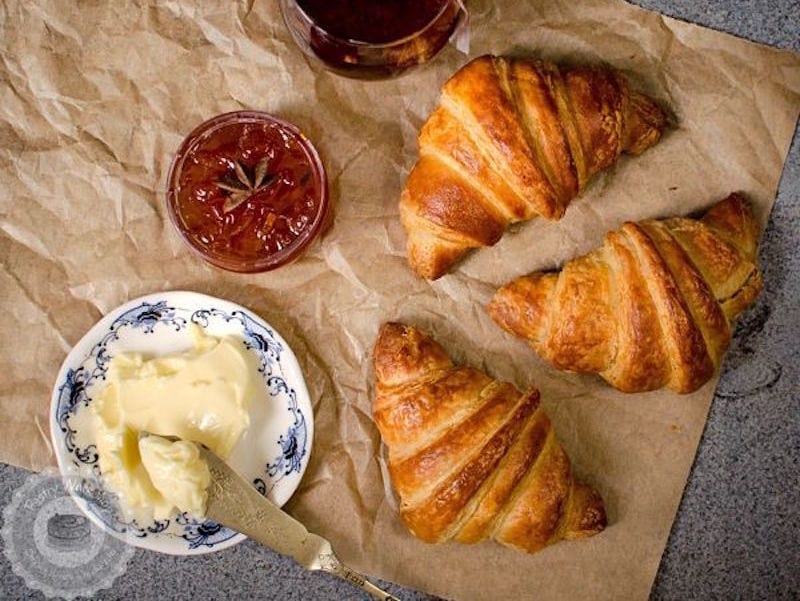Making croissants at home is a a fun process that does require some careful attention and patience, but is also incredibly rewarding.
The process can span a couple of days due to various resting and chilling stages, and a key challenge is maintaining the right temperature for both dough and butter; the butter needs to stay solid during rolling to ensure those lovely flaky layers. But don’t be deterred – let us take you on a step by step ride to mastering this classic pastry, and you’ll soon have upgraded yourself to the next level of home-baker.
Some Basic Tips
Technique:
Making croissants is considered an intermediate to advanced baking project. The process involves several techniques, including laminating the dough (the method of creating many thin layers of dough and butter through repeated folding and rolling), that might be new to beginners. But don’t be afraid – with our recipe, you’ll definitely be able to master this art!
Time:
As you can tell from the recipe, the process is spread out over a couple of days due to the multiple resting, rising, and chilling steps. This doesn’t mean you’ll be actively working on the dough the entire time, but it does require planning ahead.
Temperature is Key:
One of the challenges with croissants is managing the temperature. The butter needs to remain solid (not melting) while you roll out the dough. If the butter gets too warm and starts to melt into the dough, you won’t get the distinct flaky layers that croissants are known for. That’s why many steps involve chilling the dough in the fridge.
Patience and Practice:
Your first batch of croissants might not be perfect, and that’s okay! Like many baking projects, making croissants can require a bit of practice to master. Paying attention to how the dough feels and reacts at each step can give you valuable insights for the next time you try.
Variations:
Once you get the hang of the basic croissant dough, you can experiment with variations like chocolate-filled croissants (pain au chocolat), almond croissants, or ham and cheese-filled croissants.
Tools:
While you can make croissants with basic kitchen tools, having a few specialized items can make the process smoother:
-
- Dough Scraper: Helps lift and manipulate the dough without tearing.
- Rolling Pin: A good-quality, heavy rolling pin will help you roll the dough evenly.
- Bench Brush: Useful for brushing off excess flour during the rolling process.
- Digital Thermometer: Helps ensure the dough and butter are at the right temperature.
Satisfaction:
Despite the challenges, there’s a unique satisfaction in biting into a croissant you made from scratch. The flaky layers, the buttery aroma, and the soft interior are a celebration of your hard work and patience.
Useful Baking Terms
Preferment:
A preferment is a fermentation starter used in bread making, and it’s made before the bulk fermentation of the dough. It’s a mixture of water, flour, and yeast. Allowing this mixture to ferment before adding it to the main dough can provide more depth of flavor and improve the dough’s extensibility and strength.
Detrempe:
Detrempe is the initial dough mixture before the butter (beurrage) is added to it. In the process of making laminated doughs (like croissants or puff pastry), the detrempe is the basic dough made of flour, water, yeast, and other ingredients (excluding the large layer of butter). This dough is then enveloped with the butter layer, and through a series of folds and rolls, the desired layering effect is achieved.
Beurrage:
Beurrage refers to the butter layer that will be incorporated into the detrempe through the lamination process. For croissants and other laminated pastries, it’s important that this butter is pliable — soft enough to spread but not so soft that it mixes into the detrempe. This distinct layering is what gives croissants their flaky layers.


Step by Step Guide to Making Croissants at Home
-
Making the Preferment:
- In a bowl, mix water, yeast, and flour until well combined.
- Cover with plastic wrap.
- Let it rise at room temperature for 15 minutes.
-
Preparing the Detrempe:
- In the bowl of your stand mixer, dissolve sugar and salt in the milk and water.
- Add the prepared preferment, bread flour, and all-purpose flour. Mix until combined.
- Using the mixer, knead on low for 2 minutes and then on medium for 3 minutes. (If kneading by hand, do so for a maximum of 8 minutes.)
- Cover the bowl and let the dough rise for 1 hour.
-
Prepping for Beurrage:
- Transfer dough to a floured surface and shape into a 40 cm square.
- Sprinkle lightly with flour and roll into a 1 cm thick rectangle.
- Spread the softened butter over two-thirds of the dough, leaving one third unbuttered.
- Fold the unbuttered third over the middle section, and then fold the remaining buttered third on top (a simple fold).
- Wrap in plastic and refrigerate for 1½ hours.
-
Folding Process:
- After refrigeration, position the dough 90 degrees from its previous orientation. Roll gently into a 1 cm thick rectangle.
- Repeat the simple fold and refrigerate for 1 hour.
- Repeat the above two steps twice more.
-
Resting the Dough:
- After the final fold, wrap the dough and refrigerate overnight.
-
Shaping Croissants:
- The next day, roll the dough on a floured surface into a 40×110 cm rectangle. If the dough resists, fold and refrigerate for 20 minutes before continuing.
- Cut the rectangle into 20 cm wide strips. Then, cut triangles from each strip.
- For each triangle, make a small cut at its base. Roll the two flaps outwards from the center, gently pulling the triangle tip to elongate it as you roll.
- Place formed croissants on a baking tray lined with parchment paper, ensuring enough space for rising.
-
Final Rise & Baking:
- Mix eggs and milk for the egg wash. Brush a thin layer onto the croissants.
- Let them rise at room temperature (22-26°C) for about 2 hours.
- After proofing, gently brush croissants again with egg wash.
- Preheat oven to 190°C (with fan on). Bake croissants for 6 minutes.
- Reduce temperature to 170°C and bake for an additional 10 minutes or until golden brown. Adjust based on your oven.
-
Serve & Store:
- Enjoy your croissants fresh. If needed, freeze and reheat.

How to Make Croissants at Home
- Total Time: 17 hours 46 minutes
- Yield: 25 croissants 1x
Description
Making croissants at home takes some dedication and practice, but once you get the hang of it – it’s incredibly rewarding.
Ingredients
Preferment:
- 200 ml water (Note: Ensure water is at room temperature, ideally not exceeding 22°C)
- 40 g fresh yeast (or 16g active dry yeast)
- 150 g all-purpose flour (sifted)
Detrempe:
- The preferment from above
- 80 g white sugar
- 25 g salt
- 350 ml milk (room temperature)
- 70 ml water (room temperature)
- 600 g bread flour (sifted)
- 350 g all-purpose flour (sifted)
Beurrage:
- 600 g butter (softened but slightly cold to touch)
Egg Wash:
- 2 eggs
- 1 tablespoon milk
Instructions
- Making the Preferment:
- In a bowl, mix water, yeast, and flour until well combined.
- Cover with plastic wrap.
- Let it rise at room temperature for 15 minutes.
- Preparing the Detrempe:
- In the bowl of your stand mixer, dissolve sugar and salt in the milk and water.
- Add the prepared preferment, bread flour, and all-purpose flour. Mix until combined.
- Using the mixer, knead on low for 2 minutes and then on medium for 3 minutes. (If kneading by hand, do so for a maximum of 8 minutes.)
- Cover the bowl and let the dough rise for 1 hour.
- Prepping for Beurrage:
- Transfer dough to a floured surface and shape into a 40 cm square.
- Sprinkle lightly with flour and roll into a 1 cm thick rectangle.
- Spread the softened butter over two-thirds of the dough, leaving one third unbuttered.
- Fold the unbuttered third over the middle section, and then fold the remaining buttered third on top (a simple fold).
- Wrap in plastic and refrigerate for 1½ hours.
- Folding Process:
- After refrigeration, position the dough 90 degrees from its previous orientation. Roll gently into a 1 cm thick rectangle.
- Repeat the simple fold and refrigerate for 1 hour.
- Repeat the above two steps twice more.
- Resting the Dough:
- After the final fold, wrap the dough and refrigerate overnight.
- Shaping Croissants:
- The next day, roll the dough on a floured surface into a 40×110 cm rectangle. If the dough resists, fold and refrigerate for 20 minutes before continuing.
- Cut the rectangle into 20 cm wide strips. Then, cut triangles from each strip.
- For each triangle, make a small cut at its base. Roll the two flaps outwards from the center, gently pulling the triangle tip to elongate it as you roll.
- Place formed croissants on a baking tray lined with parchment paper, ensuring enough space for rising.
- Final Rise & Baking:
- Mix eggs and milk for the egg wash. Brush a thin layer onto the croissants.
- Let them rise at room temperature (22-26°C) for about 2 hours.
- After proofing, gently brush croissants again with egg wash.
- Preheat oven to 190°C (with fan on). Bake croissants for 6 minutes.
- Reduce temperature to 170°C and bake for an additional 10 minutes or until golden brown. Adjust based on your oven.
- Serve & Store:
- Enjoy your croissants fresh. If needed, freeze and reheat for a delightful, buttery treat!
Notes
- Ensure the water for the preferment and the milk and water for the detrempe are at room temperature, ideally no higher than 22°C.
- For beurrage, butter should be pliable yet slightly cold. Refrain from microwaving.
- Always sift flours before use to ensure a smooth texture.
- Prep Time: 90 min
- Rise Time: 16 hours
- Cook Time: 16 min
- Category: Pastries
- Method: Baking
- Cuisine: French
Nutrition
- Serving Size: 1 croissant
- Calories: 250
- Sugar: 4g
- Sodium: 230mg
- Fat: 15g
- Saturated Fat: 9g
- Unsaturated Fat: 5g
- Trans Fat: 0g
- Carbohydrates: 30g
- Fiber: 1g
- Protein: 5g
- Cholesterol: 40mg




























